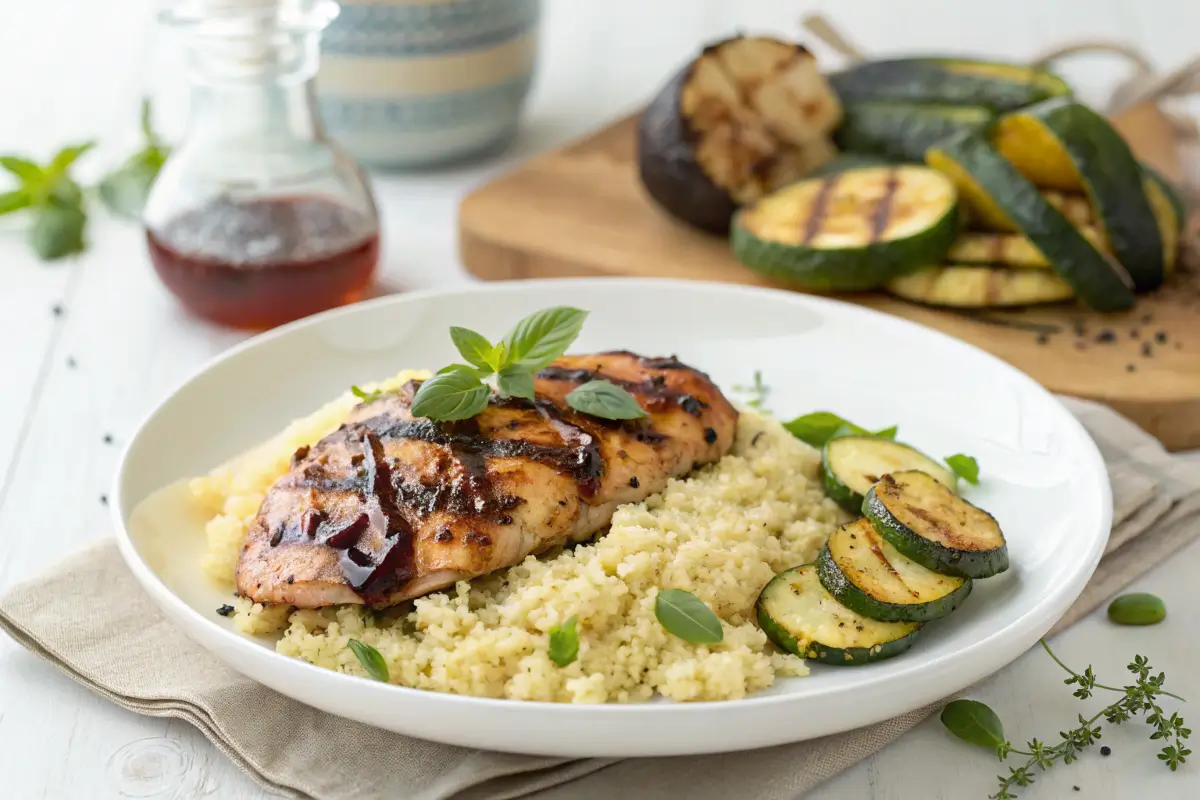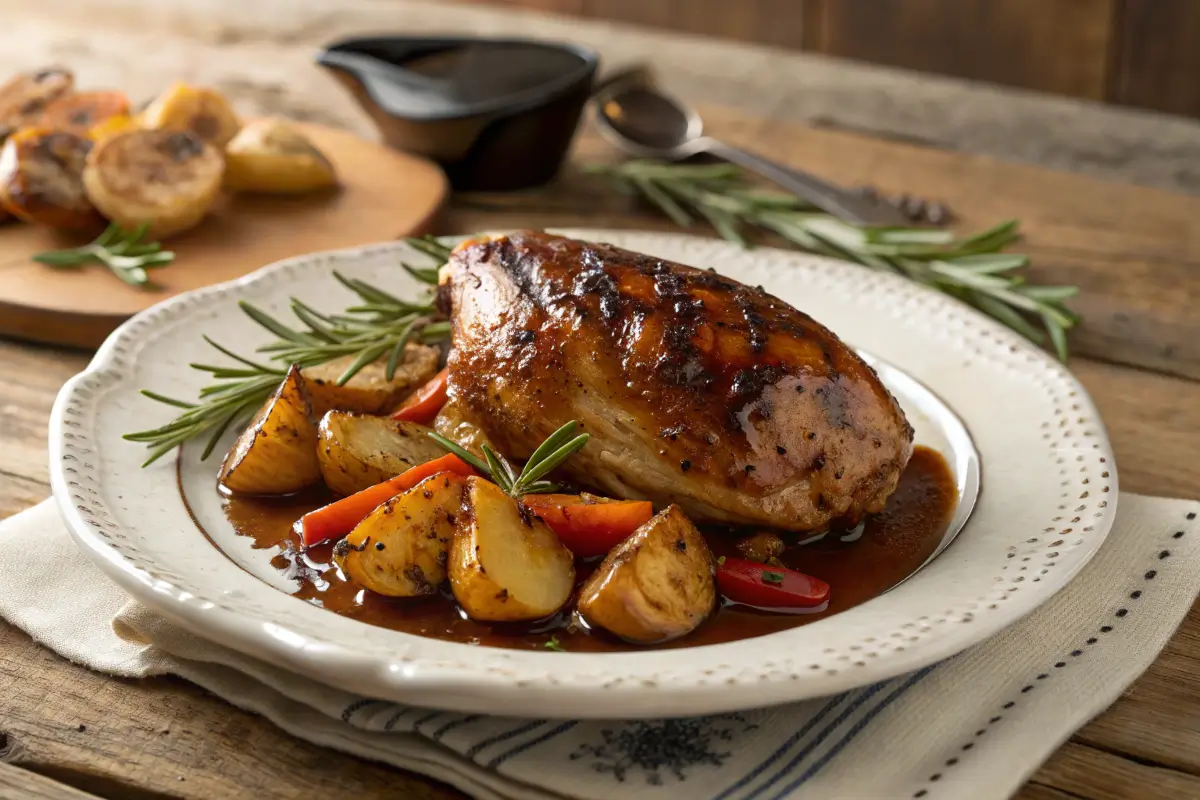
When it comes to cooking chicken, we often search for ways to enhance its flavor and texture. Balsamic vinegar has emerged as a versatile ingredient that not only elevates taste but also transforms the humble chicken into a succulent, mouthwatering dish. This article delves into the magic of balsamic vinegar, explaining how it works wonders on chicken and how you can use it in your recipes. From its tenderizing properties to flavor-boosting capabilities, you’ll discover why this pantry staple deserves a place in your kitchen.
Let’s explore everything about balsamic vinegar and its role in cooking chicken, starting with understanding what this ingredient is all about.
Understanding Balsamic Vinegar
What Is Balsamic Vinegar?
Balsamic vinegar is a rich, dark, and syrupy vinegar originating from Italy, crafted from the concentrated juice of white grapes. Known for its sweet and tangy profile, it’s a cornerstone of Mediterranean cuisine. The vinegar undergoes a slow aging process in wooden barrels, which gives it a deep, complex flavor.
There are two primary types: traditional balsamic vinegar, which is aged for several years and boasts a premium quality, and commercial balsamic vinegar, which is quicker to produce and commonly used in everyday cooking.
Types of Balsamic Vinegar and Their Uses
The uses of balsamic vinegar vary depending on its type:
- Traditional Balsamic Vinegar: Ideal for drizzling over roasted vegetables, fruits, and gourmet dishes. Its refined flavor complements high-end meals.
- Commercial Balsamic Vinegar: Perfect for marinades, dressings, and cooking, especially for dishes like balsamic chicken, due to its affordability and adaptability.
Understanding these types helps in selecting the right vinegar for your culinary needs.
Nutritional Benefits of Balsamic Vinegar
Beyond its flavor, balsamic vinegar offers health benefits:
- It’s low in calories and fat, making it a heart-healthy choice.
- Contains antioxidants that help combat oxidative stress.
- Its acetic acid content aids digestion and promotes satiety.
By incorporating balsamic vinegar into dishes like chicken, you’re not just enhancing taste but also making a healthier meal choice. So, why not experiment with this versatile condiment to create wholesome and delicious recipes?
How Balsamic Vinegar Enhances Chicken
The Chemistry Behind Balsamic Vinegar and Chicken
When balsamic vinegar meets chicken, culinary magic happens. Its acidic nature works as a tenderizer, breaking down protein fibers in the meat, making it soft and succulent. The vinegar penetrates deeply, carrying its sweet and tangy flavors along, ensuring every bite is infused with richness.
Moreover, the natural sugars in balsamic vinegar caramelize during cooking, creating a glossy, flavorful crust on the chicken. This dual action of tenderizing and flavoring is what makes balsamic vinegar a standout ingredient for poultry.
Flavor Profile Transformation: Sweet, Tangy, and Rich
Balsamic vinegar is more than just a tangy addition. It introduces a complex blend of flavors—sweetness balanced with a hint of acidity. When paired with chicken, it enhances the natural umami of the meat while introducing a subtle depth. Adding herbs like thyme or spices like paprika to a balsamic marinade takes it to another level, creating a burst of flavor that feels gourmet yet approachable.
Tenderizing Properties of Balsamic Vinegar
Ever wondered what does balsamic vinegar do to chicken? One of its unsung talents is its ability to act as a natural tenderizer. The vinegar’s acetic acid loosens the protein structures, ensuring that even lean chicken breasts remain juicy after cooking. The longer the chicken marinates, the deeper the tenderizing effect, though even a quick marinade works wonders.
For more details on cooking techniques with vinegar, check out this balsamic chicken recipe for step-by-step guidance.
Ways to Use Balsamic Vinegar with Chicken
Marinating Chicken with Balsamic Vinegar: Benefits and Techniques
Marination is the most common way to use balsamic vinegar with chicken. A simple blend of balsamic vinegar, olive oil, garlic, and honey creates a powerful marinade that not only infuses flavor but also keeps the chicken moist. Ideally, chicken should marinate for at least 30 minutes, but overnight marination yields the best results.
Key tips:
- Use a resealable bag for even coating.
- Avoid metal bowls to prevent a metallic taste from the vinegar.
Balsamic Vinegar as a Cooking Sauce: Glazing and Reduction
Balsamic vinegar is perfect for crafting a glaze or reduction. Simmering balsamic vinegar until it thickens creates a sauce that can be brushed over chicken while grilling or roasting. For added sweetness, a touch of honey can be mixed in. The glaze not only enhances the visual appeal of the dish but also delivers a burst of flavor.
Pair this method with grilled vegetables or roasted potatoes to create a complete meal.
Pairing Balsamic Chicken with Sides
The versatility of balsamic chicken means it pairs well with a variety of sides:
- Italian roasted vegetables bring a smoky flavor to complement the tangy chicken.
- Fluffy couscous or basmati rice provides a neutral base to absorb the juices.
- For a lighter option, consider a crisp arugula salad dressed with a balsamic vinaigrette.
For more side ideas, visit this guide to pairing side dishes with chicken recipes.
Popular Balsamic Chicken Recipes
Classic Balsamic Chicken Marinade Recipe
If you’re wondering what does balsamic vinegar do to chicken, this recipe showcases its full potential. A traditional balsamic chicken marinade blends balsamic vinegar, olive oil, garlic, and fresh herbs like thyme or rosemary. The marinade infuses the chicken with a balance of tanginess and sweetness, while ensuring tender and juicy meat.
Steps to Prepare:
- Mix 1/4 cup balsamic vinegar, 2 tablespoons olive oil, 3 minced garlic cloves, 1 tablespoon honey, and your choice of herbs in a bowl.
- Place the chicken in the marinade and refrigerate for at least 2 hours.
- Cook in a skillet, grill, or oven for a flavorful meal.
This recipe pairs beautifully with roasted vegetables or a fresh arugula salad.
Honey Balsamic Glazed Chicken

Honey and balsamic vinegar are a match made in culinary heaven. The natural sweetness of honey enhances the tangy richness of balsamic vinegar, creating a glossy glaze perfect for pan-seared chicken thighs.
Quick Method:
- Combine equal parts honey and balsamic vinegar with a pinch of paprika.
- Cook chicken thighs in a skillet, then pour the glaze over the chicken in the last few minutes of cooking. The glaze will thicken, coating the chicken in a shiny, flavorful layer.
Mediterranean Balsamic Chicken with Herbs
Mediterranean flavors complement balsamic chicken beautifully. Think oregano, thyme, and a splash of lemon juice combined with balsamic vinegar. This recipe is baked to perfection, creating a dish that’s both hearty and aromatic.
Steps:
- Marinate chicken with balsamic vinegar, garlic, oregano, and lemon juice for 4-6 hours.
- Bake in the oven at 375°F until golden brown and fully cooked.
Serve with couscous or grilled zucchini for a meal bursting with Mediterranean flair.

Balsamic BBQ Chicken
For those who love a smoky twist, balsamic vinegar makes an excellent base for BBQ sauce. This recipe combines balsamic vinegar, ketchup, brown sugar, and a hint of smoked paprika to create a tangy, smoky glaze.
Cooking Tips:
- Brush the sauce over chicken during the last 10 minutes of grilling.
- Reserve some sauce for dipping to enhance the BBQ experience.
Tips for Cooking with Balsamic Vinegar and Chicken
Marinating Time and Techniques
Marinating is key to achieving tender, flavorful chicken. With balsamic vinegar, marinate chicken for at least 30 minutes, though 2-4 hours is ideal for deeper flavor. Always use glass or plastic containers, as metal can react with the vinegar and alter the taste.
Pro Tip: If you’re short on time, scoring the chicken lightly helps the marinade penetrate faster.
Cooking Temperatures and Avoiding Overcooking
Chicken should be cooked to an internal temperature of 165°F for safety. Use a meat thermometer to avoid overcooking, which can dry out the meat. When using balsamic glaze, apply it during the final stages of cooking to prevent burning.
Choosing the Right Type of Balsamic Vinegar for Recipes
The type of balsamic vinegar you use matters. For marinades, commercial balsamic vinegar works well due to its sharper tang. For drizzling or glazing, opt for traditional aged balsamic vinegar for a richer, smoother taste.
Frequently Asked Questions (FAQs)
Can I Use Balsamic Vinegar for Chicken Breasts and Thighs?
Absolutely! Balsamic vinegar works wonderfully with both chicken breasts and thighs. While chicken breasts are leaner and benefit from the tenderizing properties of vinegar, thighs, with their slightly higher fat content, soak up more of the flavorful marinade. When exploring how balsamic vinegar enhances chicken, remember it adds tanginess and ensures the meat remains juicy.
How Long Should Chicken Marinate in Balsamic Vinegar?
For the best results, marinate chicken in a balsamic-based mixture for at least 30 minutes. For deeper flavors and better tenderness, aim for 2-4 hours. Avoid marinating for over 24 hours, as the acid might start breaking down the meat too much, affecting its texture.
Does Balsamic Vinegar Make Chicken Healthier?
Yes! Using balsamic vinegar is a healthy way to flavor chicken. This low-calorie ingredient adds richness without the need for extra fat or salt. Packed with antioxidants, it also promotes heart health, making it an excellent addition to balanced meals.
How Do I Prevent Balsamic Vinegar from Burning During Cooking?
To avoid burning, apply balsamic glaze or sauce during the final stages of cooking. Since the natural sugars in the vinegar caramelize quickly, use lower heat and watch the chicken closely for perfect results.
Conclusion and Final Thoughts
Balsamic vinegar is a powerhouse ingredient that transforms ordinary chicken into a flavorful masterpiece. By tenderizing the meat, infusing it with its sweet and tangy profile, and creating a caramelized finish, this versatile vinegar elevates chicken dishes to the next level.
From quick marinades to glossy glazes, its adaptability ensures there’s a recipe for every taste. Whether you prefer a Mediterranean twist, a smoky BBQ finish, or a classic honey glaze, balsamic vinegar adds depth and complexity without extra calories.
Experimenting with these techniques will enhance your meals and impress your guests. For more chicken recipes and creative cooking tips, explore other guides and collections on your favorite recipe sites. Enjoy the delicious journey of discovering new ways to transform chicken with balsamic vinegar!
How Balsamic Vinegar Complements Different Cooking Methods
Grilling with Balsamic Vinegar
Grilling chicken with balsamic vinegar unlocks a smoky flavor while maintaining juiciness. The vinegar not only tenderizes the chicken but also creates a caramelized crust due to its natural sugars. For best results, marinate the chicken beforehand and brush additional balsamic glaze during the last few minutes of grilling.
Pro Tip: Use boneless, skinless chicken thighs for quick cooking and even caramelization. Wondering, what does balsamic vinegar do to chicken on the grill? It makes it tender, juicy, and full of smoky, tangy goodness.
Baking with Balsamic Vinegar
Baking chicken with balsamic vinegar is ideal for those who love hands-off cooking. The heat of the oven intensifies the vinegar’s flavors, creating a rich glaze that pairs beautifully with herbs and spices. To bake:
- Preheat the oven to 375°F.
- Place marinated chicken in a baking dish, drizzle extra balsamic vinegar, and bake for 25-30 minutes or until the internal temperature reaches 165°F.
Bonus: Add vegetables like bell peppers and onions to the dish to soak up the juices, creating a complete, flavorful meal.
Elevating Your Dishes with Balsamic Vinegar Tips
Pairing Balsamic Chicken with Side Dishes
The beauty of balsamic chicken lies in its versatility. Pair it with:
- Creamy mashed potatoes for a comforting contrast.
- Light quinoa salad to highlight the vinegar’s tangy notes.
- Roasted Brussels sprouts for a crunchy, caramelized side that mirrors the chicken’s glaze.
Each pairing transforms the dish into a balanced and flavorful meal.
Experimenting with Flavored Balsamic Vinegars
Take your balsamic chicken to new heights by experimenting with flavored balsamic vinegars. Options like fig, pomegranate, or even white balsamic add unique twists to classic recipes. For example, pomegranate balsamic gives a subtle fruity sweetness that pairs beautifully with Mediterranean herbs.
When asking, what does balsamic vinegar do to chicken, these variations prove its versatility, showcasing how one ingredient can elevate a dish in countless ways.
With these techniques and tips, balsamic vinegar will become a staple in your chicken recipes. It’s time to explore, experiment, and enjoy the endless possibilities this ingredient brings to your cooking!

